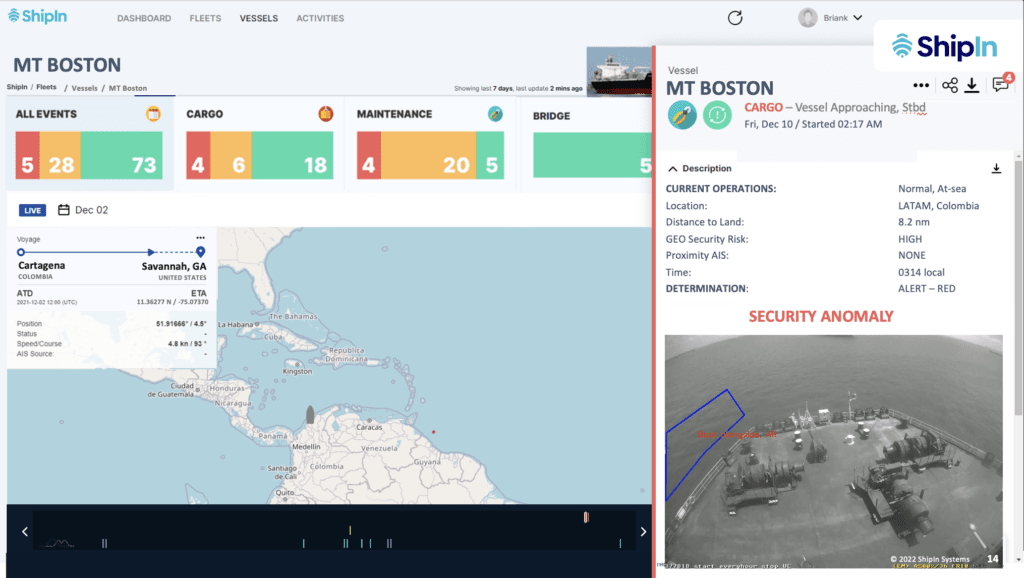When we think about building a culture of safety in the shipping industry, it’s the small, everyday safety violations that can eventually lead to high-profile incidents and serious security issues like piracy, drug smuggling, and accidents.
One seafarer skipping out on routine maintenance or violating a small safety protocol can snowball over time, eventually creating severe threats to safety in your onboard operations.
Most operators and shipowners understand this, but have limited options when it comes to improving safety on board. Building a culture of safety involves daily operational decisions and protocols that feel mundane, like wearing hard hats in certain areas of the ship, or cleaning up spills before someone can slip and fall.
Encouraging and incentivizing everyday safety habits add up to the smooth and productive operations of your ship, but there’s often no visibility from management or onboard leadership to make sure they’re happening as planned and trained.
Here’s how to use technology and real-time contextual safety alerts to more effectively build a culture of safety with your teams.
A Culture of Safety Starts with Everyday Habits
Once a ship casts off, there’s no way to know exactly what’s happening on board (without the right technology, that is.) There are thousands of daily decisions made that contribute to safe operations from closing doors to handling heavy machinery, but you’re often left poring over manually entered data and after-the-fact Captain’s reports to answer questions like:
- How smoothly did navigation go?
- Were scheduled repairs made on time?
- Were safety protocols followed?
- Did the cargo remain secure?
The commonly cited stat is that 96% of at-sea incidents are attributed to human error. This doesn’t mean that one single mistake from an individual seafarer is to blame for a major incident — quite the opposite. It refers to the fact that despite our major advances in technology onboard, your systems are still operated by humans, which introduces an element of unpredictability.
The way the workplace is set up, how work is designed, whether the equipment is maintained, and other control measures put in place through processes and protocols matter. Take, for example, bridge lighting at night. It’s a natural impulse to turn on the lights on the bridge for the night shift — but as we know, doing so while underway is a safety hazard due to significantly reduced watch visibility.
It’s exactly these seemingly minor occurrences that undermine building a culture of safety and put your crew at risk. That’s why at ShipIn, we’ve built contextual, AI-driven safety alerts for your team that can flag these kinds of safety hazards in real-time, both onboard and ashore, so you can have greater visibility into your onboard operations across your fleet and keep your team, cargo, and equipment safe.
How ShipIn Builds AI Safety Alerts
ShipIn’s FleetVision™ system uses a network of connected cameras placed at key points on board, like the bridge, the engineering room, and on deck or in cargo bays. What makes ShipIn’s solution different from standard CCTV, however, is the integrated AI system, which analyzes continuous video footage to create a digital dashboard of routine procedures, maintenance, and hazard detection.
For example, should ShipIn detect lights while underway on the bridge, you would see a simple alert: “Bridge Lighting at Night while Underway” highlighted on your dashboard. In another instance, the system might detect an unknown vessel approaching your ship in the middle of the night – a clear security alert.

Our artificial intelligence builds these types of alert by evaluating several factors:
- GPS Location: When is it dusk and dawn at these coordinates?
- Time: Is it currently between dusk and dawn?
- AIS: Is the ship currently underway? Is the other vessel on AIS?
- Light Detection: Use the camera to measure how much light is on the bridge. Is it very bright on the bridge?
- Light Distribution: Measure how light is distributed on the bridge. Is the distribution consistent with the lights being on, or is it simply light pollution from monitors or other equipment?
ShipIn uses the answers from all of the questions above to decide if the alert should be triggered or not on your comprehensive dashboard, which can be viewed not only by crew on board but by the management and support team ashore in real-time.
Alerts like this one can be used to review daily operations or discuss recent events on the sailing commercial merchant vessel without the need to watch and integrate hours, days, or weeks of multiple channels of video. From there, ship owners, Captains, and crew can take appropriate action steps to prevent further damage, initiate safety protocols, or receive updates as needed, facilitating operational efficiencies.
Designed with ship managers and seafarers in mind, ShipIn’s FleetVision™ allows your team to:
- Continuously surface relevant onboard operational incidents for early hazard detection
- Provide visibility to low-traffic areas of the vessel
- Offer remote guidance and ship-to-shore collaboration
- Automatically log events and reduce administrative work
- Share best practices and assessments for crew competency across fleets
See how ShipIn can help you build a stronger risk management culture today.


